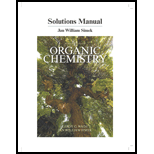
Concept explainers
(a)
Interpretation:
The monomer that might have reacted to produce the given
Concept introduction:
The ring-opening metathesis polymerization comes under the category of olefin metathesis chain-growth polymerization. In this polymerization technique, the reaction between a cycloalkene and a metal catalyst takes place that forms the polymer containing both single and double bonds.
(b)
Interpretation:
The monomer that might have reacted to produce the given polymer by using ring-opening metathesis polymerization is to be stated.
Concept introduction:
The ring-opening metathesis polymerization comes under the category of olefin metathesis chain-growth polymerization. In this polymerization technique, the reaction between a cycloalkene and a metal catalyst takes place that forms the polymer containing both single and double bonds.
Want to see the full answer?
Check out a sample textbook solution
Chapter 26 Solutions
Student's Solutions Manual for Organic Chemistry
- 24) Who suggested the first model of the atom that included more than one orbit for electrons? Dalton a. b. Thomson C. Rutherford d. Bohr 25) Which of the following compounds would be capable of hydrogen bonding? a. Ethanol b. Hydrogen Sulfide C. Ethane d. Carbon Dioxidearrow_forwardpls helparrow_forwardpls helparrow_forward
- Indicate the compound resulting from the bromination of 3,5-dimethylpyrazolearrow_forward31) The reaction profile for a given chemical reaction is shown below A Energy Reactants Products B Progress of reaction a. Which arrow represents the activation energy for the forward reaction? b. Which arrow represents the activation energy for the backward reaction? c. Is the forward reaction exothermic or endothermic? d. Is the reverse reaction exothermic or endothermic?arrow_forwardpls helparrow_forward
- 10) What is the [OH-] concentration of a solution with a pH of 12.0? 1.0 x 10¹² M a. b. 1.0 x 10-12 M C. 1.0 x 10² M d. 1.0 x 102M 11) In which block of the periodic table would you find the element gold? a. b. s block P block C. d block d. f blockarrow_forward5) Who was responsible for the first model of the atom that included electrons? a. Dalton b. Thomson c. Bohr d. Rutherford 6) Which of the following rate laws is a fourth-order reaction? a. r = k[X][Y]²[Z] b._r= k[X]²[Y]³ C. r = k[X][Y]² d._r= k[X][Y]²[Z]ª 7) The activation energy of a particular reaction will decrease if: a. A catalyst is used. b. Temperature is increased. c. Reactant concentration is increased. d. All of the abovearrow_forwardpls helparrow_forward
- State the reason why compound A (m.p. 99-100°C) is heated under vacuum.1. So that the sample heating temperature is not too high when heated under vacuum.2. So that the temperature is higher than the melting point of compound A.3. So that cold water is not required in the sublimator.arrow_forwardTo find the theoretical % yield of a given reaction:1. actual amount obtained once crystallized2. (actual amount obtained / theoretical amount) x 1003. maximum amount of product that can be obtained / amount of initial reactantarrow_forwardThe reason activated carbon decolorizes and purifies a product is:1. It helps dissolve the product and then recrystallize it.2. It reacts with impurities in the product and removes them.3. It retains impurities by adsorption, purifying the product.arrow_forward
 Chemistry: Principles and ReactionsChemistryISBN:9781305079373Author:William L. Masterton, Cecile N. HurleyPublisher:Cengage Learning
Chemistry: Principles and ReactionsChemistryISBN:9781305079373Author:William L. Masterton, Cecile N. HurleyPublisher:Cengage Learning Chemistry: Principles and PracticeChemistryISBN:9780534420123Author:Daniel L. Reger, Scott R. Goode, David W. Ball, Edward MercerPublisher:Cengage Learning
Chemistry: Principles and PracticeChemistryISBN:9780534420123Author:Daniel L. Reger, Scott R. Goode, David W. Ball, Edward MercerPublisher:Cengage Learning Organic ChemistryChemistryISBN:9781305580350Author:William H. Brown, Brent L. Iverson, Eric Anslyn, Christopher S. FootePublisher:Cengage Learning
Organic ChemistryChemistryISBN:9781305580350Author:William H. Brown, Brent L. Iverson, Eric Anslyn, Christopher S. FootePublisher:Cengage Learning EBK A SMALL SCALE APPROACH TO ORGANIC LChemistryISBN:9781305446021Author:LampmanPublisher:CENGAGE LEARNING - CONSIGNMENT
EBK A SMALL SCALE APPROACH TO ORGANIC LChemistryISBN:9781305446021Author:LampmanPublisher:CENGAGE LEARNING - CONSIGNMENT



